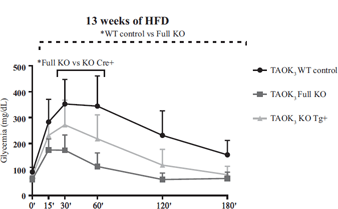BES2018 BES 2018 TAOK3 as a regulator of glucose tolerance in obesity (1 abstracts)
TAOK3 as a regulator of glucose tolerance in obesity
B Maes 1, , F Fayazpour 1, , L Catrysse 1, , G Lornet 1, , B Lapauw 3 , BN Lambrecht 1, & S Janssens 1,
1VIB IRC, Ghent, Belgium; 2Department of Internal Medicine, Ghent University, Ghent, Belgium; 3Department of Endocrinology, Ghent University Hospital, Ghent, Belgium; 4Department of Pulmonary Medicine, Erasmus MC, Rotterdam, Netherlands.
Aims or Objectives: We here describe a role for the kinase thousand and one kinase (TAOK) 3 as a modulator of insulin resistance. TAOK3 is one of three members of the TAOK family of kinases, which are classified within the Ste20-like kinases as mitogen activated protein kinase 4 kinases. TAOK3 was identified in a RNAi library screening in C. elegans as a target molecule that could revert an insulin resistance-like state induced by a daf-2 mutation (Devgen, Ghent). Moreover, TAOK3 has been linked to childhood obesity in an epigenetic study.
Methods: Using the Sanger Gene Trap ES cell platform, TAOK3−/− mice were generated in collaboration with Prof. Jody Haigh (IRC, UGhent). Importantly, the gene trap is floxed, implicating that TAOK3 expression can be rescued in a certain tissue if crossed to a specific mouse ‘cre’ line. TAOK3−/− and TAOK3+/+ control mice were placed on a 60% (high fat diet, HFD) or a 10% (standard diet, SD) fat diet.
Results: On the HFD, TAOK3−/− mice were a bit leaner than their WT littermates. The HFD fed TAOK3−/− mice had significantly lower glucose and insulin levels, as assessed by IP GTT (intra-peritoneal glucose tolerance test), PTT (pyruvate tolerance test) and ITT (insulin tolerance test). This was also true, although to a lesser extent, for the SD fed mice, despite no differences in body weight in this group. We then crossed Adipoq-cre and TAOK3 mice to generate mice with a gene trap reversal specifically in adipose tissue (KO/Tg+). Interestingly, this led to a partial reversal of the phenotype in mice on HFD (Fig. 1).

Figure 1
Conclusions or Summary: Our data demonstrate that TAOK3 is implicated in glucose tolerance and insulin sensitivity in mice, at least in part through adipose tissue. Being a kinase, TAOK3 is druggable and our data sparked interest of drug companies for targeting this kinase. Therefore, we hope that our work will lead to a novel target for the treatment of metabolic disease.
 }
}



